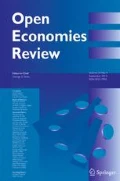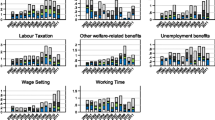Abstract
This paper analyses empirically the response of labour market indicators to changing financing conditions in a panel of 15 euro area countries from 1999Q1 to 2015Q4. Using a local projections approach, we estimate impulse responses of three margins of sectoral labour market adjustment – employment, hours worked and real wages. Consistent with recent results in the literature, we find contractionary financing shocks to depress all three indicators of the labour market. Furthermore, responses are asymmetric depending on the sign of the shock, different in magnitude depending on the sectoral composition, and sensitive to labour market institutions such as employment protection legislation and union density. Finally, labour market institutions seem to mainly affect the relative strength of the adjustment margins and not so much the overall response of the wage bill.










Similar content being viewed by others
Change history
16 July 2018
The original version of this article unfortunately contained mistakes.
16 July 2018
The original version of this article unfortunately contained mistakes.
Notes
Based on a sample of sectoral data for OECD countries, Boeri et al. (2013) find that “the shift of the Okun’s law intercept for financial crises is almost one half of that occurring during ordinary recessions”. Hence, output growth required to avoid unemployment from rising needs to be more than one and a half as strong in following financial crisis compared to non-financial recessions.
Boeri and Jimeno (2015) note that in the post-crisis period “in Germany adjustment along the intensive margin reduced the response of unemployment to the output fall, in Spain it is the decline in labour hoarding […] together with a slight increase in participation and an initial increase in hours worked per employee that explains the rise in the unemployment rate.”
For some of the most recent examples see for instance IMF (2016).
Austria, Belgium, Cyprus, Spain, Finland, France, Greece, Ireland, Italy, Luxembourg, Malta, Netherlands, Portugal, Slovenia, Slovakia.
See also IMF ( 2016) for a similar approach.
We use this measure to strip credit growth from demand driven increases, which would also directly affect employment. Results using the difference in loan growth rates are quantitatively similar.
We define programme periods as follows: Greece since 2010, Ireland 2011 to 2013, Portugal 2011 to 2014, Cyprus 2013 to 2016, Spain 2012 to 2013.
To some extent this is a result of interpolations due to data availability, which limits the variability across time, leaves however the overall trend between the beginning and end of sample observations unchanged.
In Table 2 in the Appendix, we provide a full set of regression results that correspond to baseline impulse responses shown in Figure 4 at forecast horizons h=0,4,8 Table 2 illustrates that GVA growth is an important additional driver of employment and hours worked while the change in the GVA deflator significantly determines employment growth and real wages in the short run. Figure 11 in the Appendix provides results for the whole sample including programme period observations. Differences lie in the lack of convergence of employment back to the initial level as a result of a longer lasting rebalancing process during the economic adjustment programme. Responses of hours worked turn insignificant while wage dynamics for the full sample also lack the convergence pattern.
To do so, we further augment equation (2) by including interaction terms between the indicator for the sign of the shock, the shock itself and the labour market regulation indicator. Given this triple interaction, results should be interpreted with care.
The response is not driven by a specific sector or country.
References
Abbritti M, Weber S (2018) Reassessing the role of labor market institutions for the business cycle. Int J Cent Bank 14(1):1–34
Anderton R, Hantzsche A, Savsek S, Tóth M (2017) Sectoral wage rigidities and labour and product market institutions in the Euro Area. Open Econ Rev 28(5):923–965
Auerbach A, Gorodnichenko Y (2013) Output spillovers from fiscal policy. Am Econ Rev 103(3):141–146
Bassanini A, Duval R (2006) Employment Patterns in OECD Countries: Reassessing the Role of Policies and Institutions, OECD Economics Department Working Papers, No. 486, OECD Publishing, Paris
Ben-Mohamed I, Salès M (2015) Credit imperfections, labor market frictions and unemployment: a DSGE approach. Working Papers hal-01082471, HAL
Blanchard O, Wolfers J (2000) The role of shocks and institutions in the rise of European unemployment: the aggregate evidence. Econ J, Royal Economic Society 110(462): C1–33
Blanchard O, Jaumotte F, Loungani P (2014) Labor market policies and IMF advice in advanced economies during the great recession. IZA J Labor Policy, Springer 3(1):1–23
Boeri T, Jimeno JF (2015) The unbearable divergence of unemployment in Europe. Banco de Espana Working Paper No. 1534. https://doi.org/10.2139/ssrn.2695323
Boeri T, Jimeno JF (2016) Learning from the great divergence in unemployment in Europe during the crisis. Labour Econ 41:32–46
Boeri T, Garibaldi P, Moen ER, (2013) Financial shocks and labor: facts and theories. IMF Econ Rev, Palgrave Macmillan; International Monetary Fund 61(4):631-663
Bowdler C, Nunziata L (2007) Trade Union density and inflation performance: evidence from OECD panel data. Economica, London School of Economics and Political Science 74(293): 135–159, 02
Christiano LJ, Trabandt M, Walentin K, (2011) Introducing financial frictions and unemployment into a small open economy model. J Econ Dyn Control, Elsevier 35(12):1999–2041
Freeman RB, Medoff JL (1984) What do unions do? Basic Books, New York
Georgiadis G (2014) Towards an explanation of cross-country asymmetries in monetary transmission. J Macroecon, Elsevier 39(PA):66–84
Gnocchi S, Lagerborg A, Pappa E (2015) Do labor market institutions matter for business cycles? J Econ Dyn Control, Elsevier 51(C:299–317
International Monetary Fund (2016) Time for a supply-side boost? Macroeconomic effects of labour and product market reforms. World Economic Outlook, Chapter 3, April, IMF
Jarociński M, Lenza M (2016) An inflation-predicting measure of the output gap in the euro area. Working paper series 1966, European Central Bank
Jordà Ò (2005) Estimation and inference of impulse responses by local projections. Am Econ Rev 95(1):161–182
Mumtaz H, Zanetti F (2016) The effect of labor and financial frictions on aggregate fluctuations. Macroecon Dyn 20(01):313–341
Ohanian LE, Raffo AR (2012) New measures of hours worked in the OECD: implications for business cycles, 1960-2010. J Monet Econ 59(1):40–56
van Rens T (2011) How important is the intensive margin of labor adjustment?. Economics Working Papers 1285, Department of Economics and Business, Universitat Pompeu Fabra
Visser J (2015) Data Base on institutional characteristics of trade unions, wage setting, state intervention and social pacts. University of Amsterdam
Zanetti (2015) Financial shocks and labor market fluctuations. Economics series working papers number 746. University of Oxford, Department of Economics
Author information
Authors and Affiliations
Corresponding author
Additional information
This research was partly undertaken while all three authors were at the ECB. The views expressed arethose of the authors and do not necessarily reflect those of the ECB, EIB, IMF or NIESR
Appendix
Appendix
Loan shock measure. Note: Quarterly change in percentage points, excluding programme period observations. Solid line depicts median across countries. Dashed lines depict interquartile range across countries. Loan shocks are measured using the residual from a regression of real annual loan growth on its quarterly lag and GDP growth, multiplied by −1
Rights and permissions
About this article
Cite this article
Hantzsche, A., Savsek, S. & Weber, S. Labour Market Adjustments to Financing Conditions under Sectoral Rigidities in the Euro Area. Open Econ Rev 29, 769–794 (2018). https://doi.org/10.1007/s11079-018-9485-0
Published:
Issue Date:
DOI: https://doi.org/10.1007/s11079-018-9485-0
Keywords
- Labour market institutions
- Employment
- Wages
- Sectoral adjustment
- Financing conditions
- Local projections method











